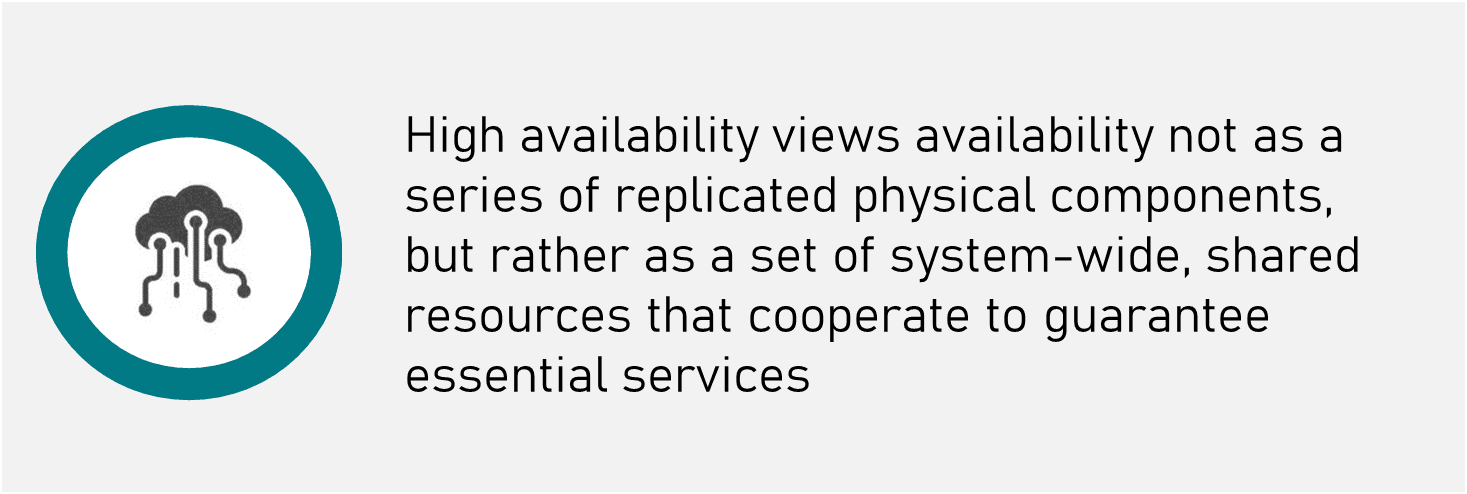What is High Availability? Ensuring Your Business Systems are always available

On this page:
What is High Availability?
In computing, ‘Availability’ refers to the period when a service is available and the time taken for the system to respond to a user request. High Availability (HA) is a state of continuous operation in an IT component or system for a specific period. It is a system characteristic that assures an agreed level of performance time. High Availability is a technology concept that involves eliminating downtime and single points of failure to ensure that the service is available even when an element fails. It enables the IT system to function continuously even if some components fail. It is highly significant for critical systems where disruption could result in adverse effects and financial losses. Data centers and healthcare facilities, for example, need high availability and no downtimes for efficient execution of their everyday tasks. Organizations use several business-critical applications, including eCommerce applications, data warehouses, finance systems, business intelligence systems, supply chain management, and CRM. Whenever a database, application, or system fails, such businesses should have measures in place to keep systems up and running to reduce the risk of losing revenue, productivity, and customer trust.  High availability does not guarantee there is no possibility of disruption. However, it makes sure the IT team has taken the necessary steps to facilitate business continuity. In simple words, high availability involves eliminating a single point of failure. Every component of the IT system should be completely redundant at the application and network level to guarantee the highest level of availability.
High availability does not guarantee there is no possibility of disruption. However, it makes sure the IT team has taken the necessary steps to facilitate business continuity. In simple words, high availability involves eliminating a single point of failure. Every component of the IT system should be completely redundant at the application and network level to guarantee the highest level of availability.
How to measure High Availability?
High availability is generally measured against a 100 per cent never-fail or operational standard. It is expressed as a percentage indicating the uptime expected from a system or component in a specific time. A common standard is the 99.999% availability known as the ‘five 9s’. Two 9s refers to a system that offers 99% availability in one year, allowing 1% downtime or unavailability of 3.65 days. The value of high availability is calculated depending on several factors, including scheduled and unscheduled maintenance periods and the time it takes to recover from a possible failure. Industry standards suggest that most services offer anywhere between 99 and 100 per cent uptime. Cloud providers have some form of Service Level Agreement around high availability. For example, industry giants like Amazon, Google, and Microsoft have the SLA set at 99.9% or ‘three 9s’. Such a value suggests that the company has a reliable system uptime.
Why is High Availability important?
Whatever be the cause of the downtime, it can affect the business health adversely. It can result in lost business opportunities, damage to brand image, lost productivity, and data loss. The costs associated with damage from downtime can range from a slight budget imbalance to a considerable loss of revenue and big financial problems. This is why IT teams constantly strive to reduce downtime and improve availability. However, minimizing the effects of downtime is not the only reason businesses should aim for high availability. Some other causes are:
- Ensuring Data Security – With high availability, you can minimize the occurrence of system downtime and reduce the risks of losing critical business data through unauthorized access or theft.
- Maintaining Brand Reputation – Availability is a significant indicator of the quality of service. Businesses can leverage reliable systems to maintain uptime and build a strong brand image in the market.
- Building Customer Relationships – Frequent disruptions from downtime can result in customer dissatisfaction. High-availability environments minimize the chances of downtime and help businesses keep customers happy and build lasting relationships with them.
- Keeping Up with SLAs – Ensuring system uptime is one of the most important things you can do to deliver high-quality service to customers. High-availability systems help adhere to SLAs all the time.

High Availability Metrics
High availability can be measured with the help of several metrics. The two most common metrics used to assess high availability are RTO (Recovery Time Objective) and RPO (Recovery Point Objective).
- RTO – The maximum duration of tolerance for an outage. Applications that involve online transactions tend to have the lowest RTOs. Critical systems also have an RTO of only a few seconds.
- RPO – The maximum amount of data loss a system can tolerate in failure. High availability demands an RPO of zero, which means there should be no data loss in case of an event.
Learn: Recovery Time Objective (RTO) and Recovery Point Objective (RPO)
High Availability System Components
A broad range of factors have to be considered when implementing high availability. While the software is the most crucial component, high availability depends on many other factors, including:
- Hardware – Servers in a highly available environment must have resilience for hardware failures such as network interfaces and hard disks and other issues like power outages.
- Software – The entire IT system, including the applications and the operating systems, should be capable of handling possible failures that could demand a system restart.
- Environment – If the business has servers in a single geographical area, an environmental condition like a flood or earthquake can take down the entire system. It is important to have redundant servers across locations and datacentres for improved reliability.
- Network – One of the most common problems is unexpected network outages. A redundant network strategy should be in place for such possible failures.
- Data – Many factors can be responsible for lost and inconsistent data. It need not be only due to hard disk failure. High availability requires that the system accounts for data security in case of a failure.
How is High Availability achieved?
Presented below are some of the ways you can achieve high availability:
- Scale-up and down – One way to achieve high availability is to scale the servers up and down to suit the availability and load of the application. At the server level, you can implement horizontal and vertical scaling.
- Deploy multiple servers – Overloaded servers are most likely to slow down and malfunction. An effective way to deal with this problem is to implement applications over multiple servers to keep them running efficiently to minimize downtime.
- Maintain an automated backup system – Automating an online backup ensures the safety of critical business data if you miss saving files manually. Such a practice is beneficial under various circumstances, including file corruption, natural disasters, and internal problems.

Best Practices to maintain High Availability systems
Presented are some best practices to help you maintain high availability across the IT environment.
Implement geographical redundancy
Geographic redundancy is the only line of defense against a failure in events like natural disasters. It can be accomplished by deploying multiple servers across geographic locations. A good idea is to choose globally distributed locations instead of localized servers. Independent stacks should be executed across these sites to make sure the system keeps running even if one of them fails.
Achieve strategic redundancy
Critical IT tasks demand redundancy more than other operations not frequently used. Instead of implementing redundancy for tasks, this means you should focus on the strategic introduction of redundancy for critical workloads to reach the targets for ROI.
Use failover systems
A high availability environment generally consists of many servers with failover capabilities. A failover is a backup facility where the functions of a system component are automatically handled by another system when the former experiences downtime or failure.
Implement network load balancing
You can implement load balancing to improve the availability of your critical application. If a server fails, all the instances are replaced, and the traffic automatically gets redirected to functioning servers. Load balancing facilitates scalability as well as high availability. It can be implemented with a push or pull model and effectively introduces high fault tolerance levels in the applications.
Synchronize data to meet RPO
Recovery Point Objective (RPO) is the maximum amount of data the business can lose within a period crucial to the business to result in significant damage. Companies looking to achieve maximum availability should set the RPO to 60 seconds or less. Selecting the source and target solutions is essential so that business data is never more than 60 seconds out of sync. This means you never lose more than a minute worth of data, even when the primary source has a failure. 
Final Thoughts
Employing highly available systems is fundamental for businesses, particularly for critical applications and databases. It focuses on assuring a high level of performance for a component or system over time. While the implementation can appear complex at first, it can deliver impressive benefits for businesses relying on IT systems and applications.

